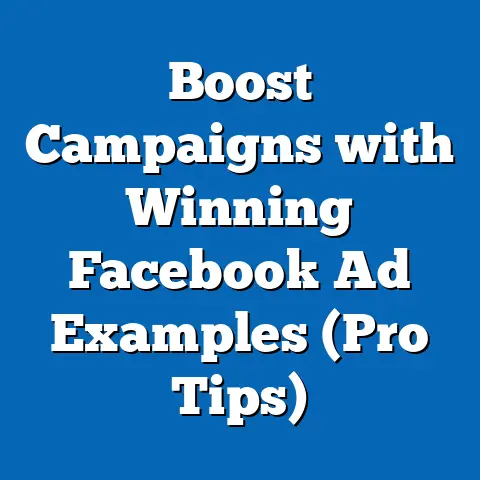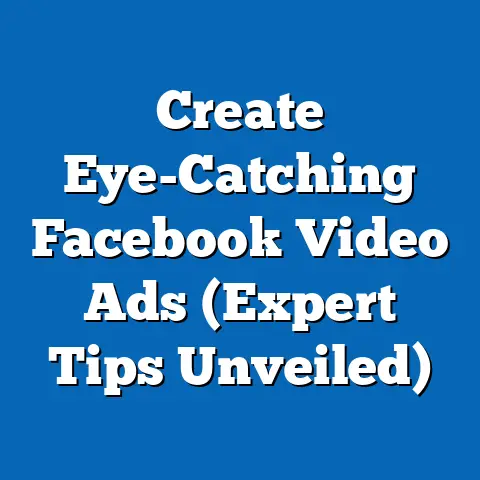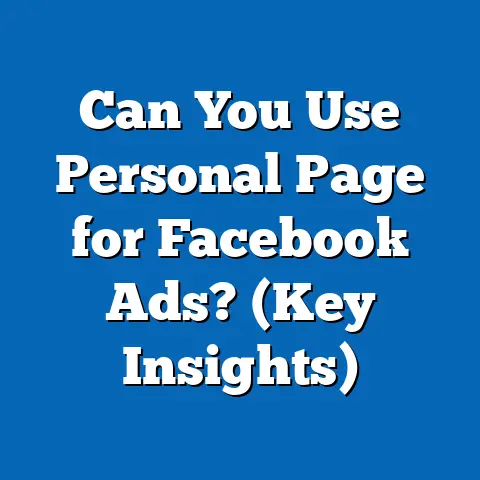Master fb ad Conversions (Proven Strategies for Success)
Facebook advertising can feel like navigating a labyrinth. You’re constantly bombarded with new features, algorithm updates, and supposed “guru” tactics. But here’s the truth: mastering Facebook ad conversions isn’t about chasing the latest shiny object. It’s about understanding the fundamentals, crafting compelling messages, and relentlessly optimizing based on data.
According to a recent report by Hootsuite, Facebook ads boast an average conversion rate of 9.21%. That’s a powerful statistic, highlighting the platform’s potential to deliver real results. But that potential only translates into reality when you have a solid strategy in place. Over the years, I’ve worked with businesses of all sizes, from scrappy startups to established enterprises, and I’ve seen firsthand how the right approach can transform a struggling campaign into a conversion powerhouse. In this article, I’m going to share the proven strategies I’ve used to help my clients achieve significant growth through Facebook ads.
1. Understanding Facebook Ad Conversions
Before we dive into the nitty-gritty tactics, let’s define what we mean by “conversion.” In the context of Facebook advertising, a conversion is simply a desired action that you want users to take after seeing your ad. This could be anything from making a purchase to signing up for a newsletter, downloading an app, or even just visiting a specific page on your website.
Different Types of Conversions:
- Purchases: The holy grail for most e-commerce businesses. This is when a user clicks on your ad and completes a purchase on your website.
- Sign-Ups: Ideal for building your email list or attracting new users to your platform.
- Lead Generation: Collecting contact information from potential customers who are interested in your products or services. This is common for B2B businesses.
- App Installs: Driving downloads of your mobile app.
- Website Traffic: Sending users to your website to learn more about your brand and offerings.
- View Content: Tracking when users view specific content on your website, such as product pages or blog posts. This can be useful for understanding user engagement and retargeting.
Why Understanding Your Audience Matters
The foundation of any successful Facebook ad campaign is a deep understanding of your target audience. You need to know their demographics, interests, behaviors, pain points, and aspirations. This knowledge will inform every aspect of your campaign, from the ad copy and visuals to the targeting options you choose.
For example, if you’re selling organic baby food, you’ll want to target parents with young children who are interested in health and wellness. You might also consider targeting users who have recently purchased baby products or joined parenting groups on Facebook.
Setting Clear Conversion Goals
Before you even create your first ad, you need to define your conversion goals. What specific action do you want users to take after seeing your ad? How will you measure the success of your campaign?
Your goals should be specific, measurable, achievable, relevant, and time-bound (SMART). For example, instead of saying “I want to increase sales,” you might say “I want to increase online sales of our organic baby food by 20% in the next three months.”
By setting clear conversion goals, you’ll be able to track your progress and make data-driven decisions about how to optimize your campaign.
Key Takeaway: Conversions are the desired actions you want users to take after seeing your ad. Understanding your audience and setting clear conversion goals are crucial for success.
2. Crafting Compelling Ad Copy
Your ad copy is your opportunity to grab attention, pique interest, and persuade users to take action. It’s the voice of your brand, and it needs to be clear, concise, and compelling.
Key Elements of Effective Ad Copy:
- Headline: The first thing users see, so it needs to be attention-grabbing and relevant.
- Body Text: Provides more detail about your offer and explains why users should take action.
- Call-to-Action (CTA): Tells users exactly what you want them to do (e.g., “Shop Now,” “Learn More,” “Sign Up”).
Tips for Writing Persuasive and Engaging Copy:
- Know Your Audience: Tailor your message to their specific needs and interests.
- Highlight Benefits, Not Just Features: Explain how your product or service will solve their problems or improve their lives.
- Use Strong Verbs and Action Words: Create a sense of urgency and excitement.
- Keep It Concise: Get to the point quickly and avoid jargon.
- Use Social Proof: Include testimonials, reviews, or case studies to build trust.
- Ask Questions: Engage users and encourage them to think about their needs.
- Create a Sense of Scarcity or Urgency: Encourage users to act now before they miss out.
Examples of High-Converting Ad Copy:
-
Example 1 (E-commerce):
- Headline: 50% Off Summer Sale – Don’t Miss Out!
- Body Text: Get ready for summer with our biggest sale of the year! Shop now and save 50% on all swimwear, sandals, and sunglasses. Limited time only!
- CTA: Shop Now
-
Example 2 (Lead Generation):
-
Headline: Free Guide: 5 Secrets to a Healthier Life
- Body Text: Discover the simple steps you can take to improve your health and well-being. Download our free guide today and start living your best life!
- CTA: Download Now
-
Example 3 (App Install):
-
Headline: The #1 Fitness App – Get Your First Month Free!
- Body Text: Reach your fitness goals with our personalized workout plans and expert coaching. Download the app today and get your first month free!
- CTA: Install Now
Example 1 (E-commerce):
- Headline: 50% Off Summer Sale – Don’t Miss Out!
- Body Text: Get ready for summer with our biggest sale of the year! Shop now and save 50% on all swimwear, sandals, and sunglasses. Limited time only!
- CTA: Shop Now
-
Example 2 (Lead Generation):
-
Headline: Free Guide: 5 Secrets to a Healthier Life
- Body Text: Discover the simple steps you can take to improve your health and well-being. Download our free guide today and start living your best life!
- CTA: Download Now
-
Example 3 (App Install):
-
Headline: The #1 Fitness App – Get Your First Month Free!
- Body Text: Reach your fitness goals with our personalized workout plans and expert coaching. Download the app today and get your first month free!
- CTA: Install Now
Example 2 (Lead Generation):
Headline: Free Guide: 5 Secrets to a Healthier Life
Example 3 (App Install):
Headline: The #1 Fitness App – Get Your First Month Free!
The Power of A/B Testing
A/B testing is the process of comparing two versions of your ad copy to see which one performs better. This is a crucial step in optimizing your campaigns and finding what resonates most with your target audience.
You can A/B test different headlines, body text, CTAs, and even visual elements. The key is to only change one variable at a time so you can accurately measure the impact of each change.
For example, you might test two different headlines:
- Headline A: “50% Off Summer Sale – Don’t Miss Out!”
- Headline B: “Summer Sale: Save 50% on Your Favorite Styles”
Run both ads for a set period of time and then analyze the results. Which headline generated more clicks, conversions, and overall engagement? Use this data to inform your future ad copy decisions.
I once worked with a clothing retailer who was struggling to get traction with their Facebook ads. We ran a series of A/B tests on their ad copy, and we discovered that using a more conversational and relatable tone resonated much better with their target audience. We also found that highlighting specific product features, rather than just general benefits, led to a significant increase in conversions.
Key Takeaway: Crafting compelling ad copy is essential for driving conversions. Use clear, concise, and persuasive language, highlight benefits, and always A/B test different versions to find what works best.
3. Visuals that Drive Conversions
In the world of Facebook advertising, visuals are king. They’re the first thing users see, and they have the power to grab attention, convey your brand message, and drive conversions.
The Role of Visuals in Facebook Ads:
- Attract Attention: Stand out from the noise of the news feed.
- Convey Your Brand Message: Communicate your brand identity and values.
- Tell a Story: Engage users and create an emotional connection.
- Showcase Your Products or Services: Highlight the features and benefits of your offerings.
- Drive Conversions: Encourage users to take action.
Guidelines for Selecting Images or Videos:
- Use High-Quality Images: Avoid blurry or pixelated images.
- Choose Relevant Images: Make sure the images are related to your product or service and your target audience.
- Use Eye-Catching Colors and Designs: Grab attention and stand out from the crowd.
- Show People Using Your Products: Help users visualize themselves using your products or services.
- Use Videos to Tell a Story: Engage users and create an emotional connection.
- Optimize for Mobile: Make sure your visuals look good on all devices.
Maintaining Consistency Between Visuals and Ad Copy:
It’s crucial to maintain consistency between your visual elements and ad copy. Your visuals should support your message and reinforce your brand identity.
For example, if your ad copy is highlighting the luxury and sophistication of your brand, your visuals should reflect that. Use high-end photography, elegant designs, and a refined color palette.
The Power of User-Generated Content and Testimonials:
User-generated content (UGC) is any content created by your customers, such as photos, videos, or reviews. This type of content can be incredibly effective in Facebook ads because it’s authentic and relatable.
Testimonials are another powerful visual strategy. Include quotes from satisfied customers that highlight the benefits of your products or services.
I remember working with a local restaurant that was struggling to attract new customers. We decided to run a Facebook ad campaign featuring photos of their most popular dishes, along with testimonials from happy customers. The results were incredible. The ads generated a huge amount of engagement, and the restaurant saw a significant increase in foot traffic.
Key Takeaway: Visuals are crucial for driving conversions in Facebook ads. Use high-quality images and videos that are relevant to your audience and consistent with your brand message. Consider using user-generated content and testimonials to build trust and credibility.
4. Targeting the Right Audience
Targeting the right audience is arguably the most important factor in determining the success of your Facebook ad campaigns. If you’re showing your ads to the wrong people, you’re wasting your time and money.
The Importance of Audience Targeting:
- Reach the Right People: Show your ads to users who are most likely to be interested in your products or services.
- Increase Conversion Rates: By targeting the right audience, you’ll increase the likelihood that users will take the desired action.
- Reduce Ad Spend: Avoid wasting money on showing your ads to people who are not interested in your offerings.
- Improve ROI: By targeting the right audience and increasing conversion rates, you’ll improve the overall return on investment of your Facebook ad campaigns.
Various Targeting Options Available:
- Demographics: Target users based on age, gender, location, education, and other demographic factors.
- Interests: Target users based on their interests, hobbies, and activities.
- Behaviors: Target users based on their online and offline behaviors, such as purchase history, travel habits, and device usage.
- Custom Audiences: Target users who have already interacted with your business, such as website visitors, email subscribers, or app users.
- Lookalike Audiences: Create audiences that are similar to your existing customers or website visitors.
Strategies for Creating Lookalike Audiences:
Lookalike audiences are a powerful way to expand your reach while maintaining high conversion potential. Facebook uses its vast database of user information to identify users who share similar characteristics with your existing customers or website visitors.
To create a lookalike audience, you’ll need to provide Facebook with a source audience, such as a list of your customers or a pixel tracking website visitors. Facebook will then analyze the characteristics of this source audience and create a new audience of users who share similar traits.
Case Studies of Precise Targeting:
- Case Study 1 (E-commerce): A clothing retailer used precise targeting to reach women aged 25-45 who were interested in fashion, shopping, and online boutiques. They also targeted users who had recently purchased clothing online. This precise targeting led to a 50% increase in conversion rates.
- Case Study 2 (Lead Generation): A B2B software company used precise targeting to reach business owners and managers who were interested in software, technology, and business growth. They also targeted users who had visited their website or downloaded their free trial. This precise targeting led to a 30% increase in lead generation.
- Case Study 3 (App Install): A mobile game developer used precise targeting to reach users who were interested in gaming, mobile apps, and specific game genres. They also targeted users who had previously installed similar games. This precise targeting led to a 40% increase in app installs.
I had one client, a subscription box service for dog owners, who was struggling to find the right audience for their ads. We started by targeting broad interests like “dogs” and “pet lovers,” but the results were underwhelming. Then, we decided to get more specific. We targeted users who had liked pages related to specific dog breeds, attended dog shows, or purchased dog-related products online. Suddenly, our conversion rates skyrocketed. We realized that the key was to identify the super fans – the people who were truly passionate about their furry friends.
Key Takeaway: Targeting the right audience is crucial for Facebook ad success. Use a combination of demographic, interest, behavioral, custom, and lookalike audiences to reach the people who are most likely to convert.
5. Optimizing Ad Placement and Budget
Where your ads appear on Facebook and how much you spend on them can have a significant impact on your conversion rates.
The Significance of Ad Placement:
Facebook offers a variety of ad placements, including:
- News Feed: The most common placement, where ads appear in users’ news feeds alongside organic content.
- Stories: Full-screen, ephemeral ads that appear in users’ stories.
- Audience Network: Ads that appear on third-party websites and apps that are part of Facebook’s Audience Network.
- Right Column: Ads that appear in the right column of the Facebook website (primarily for desktop users).
- Instant Articles: Ads that appear within Instant Articles, which are fast-loading articles published on Facebook.
The best placement for your ads will depend on your target audience, your ad creative, and your conversion goals.
Choosing the Right Ad Placement:
- News Feed: Ideal for reaching a broad audience and driving website traffic or conversions.
- Stories: Ideal for engaging younger audiences and showcasing your brand in a creative way.
- Audience Network: Ideal for extending your reach beyond Facebook and targeting users who are not active on the platform.
- Right Column: Ideal for driving brand awareness and targeting desktop users.
- Instant Articles: Ideal for driving traffic to your articles and engaging users with long-form content.
Budget Allocation and Bidding Strategies:
Your budget is the amount of money you’re willing to spend on your Facebook ad campaigns. Your bidding strategy is how you tell Facebook to bid on ad placements.
Facebook offers a variety of bidding strategies, including:
- Lowest Cost: Facebook will try to get you the most results for your budget.
- Cost Per Result Goal: You set a target cost per result, and Facebook will try to achieve that goal.
- Manual Bidding: You manually set your bids for each ad placement.
The best bidding strategy for you will depend on your budget, your conversion goals, and your level of experience.
Monitoring Ad Performance:
It’s crucial to monitor your ad performance regularly to ensure that you’re getting the best results for your budget. Track key metrics such as click-through rate (CTR), conversion rate, cost per conversion, and return on ad spend (ROAS).
If you see that your ads are not performing well, don’t be afraid to make changes. Experiment with different ad placements, bidding strategies, and targeting options.
I once worked with a client who was spending a significant amount of money on Facebook ads, but they weren’t seeing the results they wanted. After analyzing their ad performance, we discovered that they were primarily targeting desktop users, even though the majority of their customers were using mobile devices. We shifted their budget to mobile placements, and their conversion rates immediately improved.
Key Takeaway: Optimizing ad placement and budget is essential for maximizing your conversion rates. Choose the right placements for your audience and goals, experiment with different bidding strategies, and monitor your ad performance regularly.
6. Analyzing and Iterating for Continuous Improvement
Facebook advertising is not a “set it and forget it” activity. It requires ongoing analysis, testing, and optimization.
The Importance of Data Analysis:
Data analysis is the process of examining your ad performance data to identify trends, patterns, and areas for improvement. By analyzing your data, you can learn what’s working, what’s not, and how to optimize your campaigns for better results.
Key Performance Indicators (KPIs) to Track:
- Click-Through Rate (CTR): The percentage of users who click on your ad after seeing it.
- Conversion Rate: The percentage of users who take the desired action after clicking on your ad.
- Cost Per Conversion: The amount of money you spend to get one conversion.
- Return on Ad Spend (ROAS): The amount of revenue you generate for every dollar you spend on advertising.
- Relevance Score: A metric that indicates how relevant your ad is to your target audience.
A Step-by-Step Approach to Analyzing Ad Performance:
- Set Up Tracking: Make sure you have proper tracking in place to measure your ad performance. This includes installing the Facebook pixel on your website and setting up conversion tracking.
- Gather Data: Collect data on your ad performance over a set period of time (e.g., one week, one month).
- Analyze Data: Examine your data to identify trends, patterns, and areas for improvement.
- Identify Areas for Improvement: Based on your analysis, identify specific areas where you can improve your ad performance.
- Test and Iterate: Make changes to your campaigns based on your findings and test the results.
- Repeat: Continue to analyze, test, and iterate your campaigns for continuous improvement.
Constantly Test and Iterate Your Strategies:
A/B testing is a crucial part of the analysis and iteration process. Continuously test different ad copy, visuals, targeting options, and bidding strategies to see what works best.
For example, you might test two different headlines:
- Headline A: “Get 20% Off Your First Order!”
- Headline B: “Shop Now and Save 20%!”
Run both ads for a set period of time and then analyze the results. Which headline generated more clicks, conversions, and overall engagement? Use this data to inform your future ad copy decisions.
I always tell my clients that Facebook advertising is a marathon, not a sprint. It’s a continuous process of learning, testing, and optimizing. The more you experiment and analyze your data, the better you’ll become at creating high-converting ad campaigns.
Key Takeaway: Data analysis is crucial for improving conversion rates. Track key KPIs, analyze your data, identify areas for improvement, and constantly test and iterate your strategies.
Conclusion
Mastering Facebook ad conversions requires a combination of strategic planning, creative execution, and ongoing analysis. By understanding the fundamentals, crafting compelling messages, targeting the right audience, optimizing your ad placement and budget, and continuously analyzing your data, you can unlock the full potential of Facebook advertising to drive significant growth and success for your business. Remember, it’s not about finding a magic bullet or a secret hack. It’s about putting in the work, staying persistent, and always striving to improve. So, dive in, experiment, and watch your conversion rates soar!






